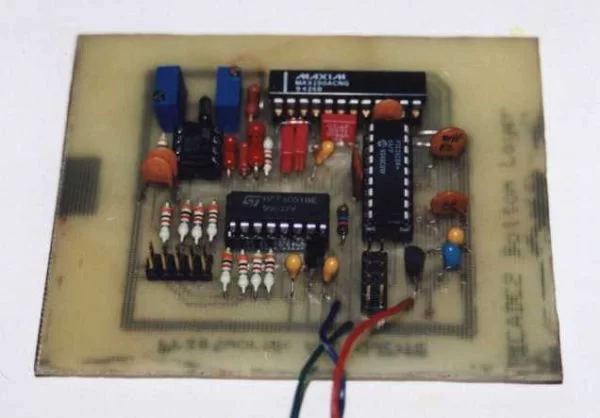This is an old design. Some of the components may be difficult to buy. If you would like to build an even better and cheaper A/D converter, take a look at the new PICADC3 design. The PICADC is a simple 12-bit, 8-channel analog to digital converter (with 4 additional digital inputs), which may be connected to the PC through the serial interface (RS232).
The sequence of sampled channels, and sampling frequence are programmed by the PC.
The maximal sampling frequency is limited by the data transmission rate, and at 115200 baud is equal to ca. 3kHz for 1 channel without digital inputs, and to ca. 500 Hz for 8 channel with digital inputs.
The analog input voltage range is -2.5V to 2.5V.
The digital inputs may be used for recording additional digital signals, eg. the time code used to synchronize the recorded data with other events.
The PICADC is based on PIC16F84 (or 166C84) microcontroller, and MAX190 (or MAX191) ADC.
The device is mounted on a small single-sided printed board, easy to prepare even at home, shown in the figure below (and available in the Easytrax for DOS format). There also printouts of the bottom layer, and top overlay available in the PDF format
The schematic diagram of PICADC is shown in the picture below, and is also available in the PDF format.
The R18 and R21 resistors are not mounted on my board. The R18 may be used to change the compensation mode of internal voltage reference in MAX190/191 (see the MAX190/191 data sheet), and R21 may be used to pull up the data line, when MAX190’s DOUT is in high impedance state.
The 4u7 capacitors (C4, C5, C7, C8, C10) should be tantalium capacitors (watch the polarity, when mounting them!).
The PICADC was intended to be a part of an optoisolated data acquisition system. Therefore its PCB does not contain the RESET circuitry and RS level converters, which should be connected through the transoptors. However usually the RESET switch is not needed and you can connect the ~RST pin (7) in the J2 connector to the +5V (J2 pin 8). If the optoisolation is not needed, you can use the MAX232 as the level converter, or simple circuits shown in the figure below:
For more detail: PICADC – a free, PIC based “intelligent” A/D converter using PIC16F84



